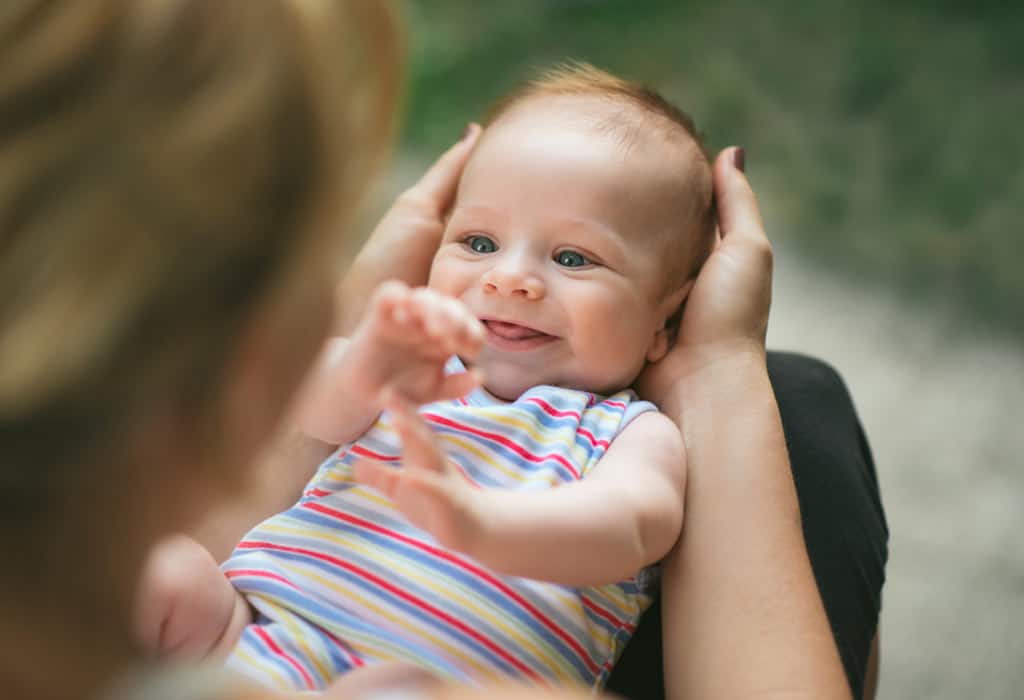
Table of Contents
As a 2-month-old baby, your little one would have already started to make sense of things and you would now see them doing more than just sleeping, eating, and crying. They’ll also now be awake for longer stretches than before and you could use all this awake time for bonding and play with them!
Your 2-month-old Baby Milestones: Baby's Development And Growth
1. Sleeping hours and patterns
Newborns at 2 months of age need to sleep for at least 14-17 hours a day. Though this is the required number of hours, it doesn’t mean that they would sleep through the night for 14 or 17 hours in one stretch; they would instead wake up every two to four hours to eat.
2. Making Your 2-months-old Baby Fall Asleep
You can continue with offering your baby a pacifier at nap and sleep times. Pacifier use has been associated with a decreased incidence of SIDS, so it is a part of the American Academy of Pediatrics’ safe sleep recommendations. Your 2 months old baby might still be comforted by swaddling and it is a safe practice to use if your baby is not able to roll over yet.
At 2 months old, most toddlers cannot yet sleep through that night—that particular milestone will not happen until your baby is closer to 12 weeks or 3 months of age. At this stage, most of the babies are still waking up one to two times a night, usually for feeding.
3. Feeding requirements
It is generally recommended to feed your 2-month-old baby as much as they want to eat and until they themselves say no to food at this age. A general rule of thumb, however, is to feed your baby 4 to 6 ounces of breast milk or formula milk every three-four hours. Milk or feeding is necessary for your baby because this is literally the nectar to keep them going. Your baby will need to be nursed around 6-10 times in a 24 hour period.
4. 2 month old baby weight and height
The average weight of a 2-month-old baby girl is 11.3 pounds while the average weight of a baby boy at 2 months is 12.3 pounds. Girls average at 22.5 inches in height whereas boys average at about 23 inches tall.
5. Your baby's bowel movements
Though your 2-month-old baby will be eating a lot at this point, they will have fewer bowel movements, at times even no bowel movements for one or two days straight. Though this may seem alarming, it is absolutely ok for babies at 2 months old to have an erratic bowel movement because as they get bigger, so does their bowel, allowing them to be able to hold the waste in their tummies for longer.
2-Month-Old Baby: Doctor Visit
Your 2-month-old baby will have to be given a couple of more shots. The sight of a syringe entering their body may churn your insides, you, as the parent, need to be strong and have to understand it is for your angel’s protection after all!
- Your baby’s overall check-up
For their two-month physical checkup, your baby’s pediatrician will check their weight, length, and baby’s head circumference to figure out the baby’s progress and to match it with what’s expected. Your doctor will also ask you about your baby’s behavior and reflexes; whether they smile or if they notice their own hands and if they turn when they hear a sound etc.
- DTaP vaccine
DTaP vaccine, a vaccine that protects your baby against diphtheria, tetanus, and pertussis, is given in the form of five shots over a period of time and the first shot is administered at 2 months old.
- Hib vaccine
The Hib vaccine, a vaccine that protects your 2-month-old baby from Haemophilus influenza type b, or Hib is also administered at 8 weeks or 2 months old.
Pro tip: When you take your baby to the doctor’s, they will have to be undressed for the administration of shots and for the pediatrician to be able to take all measurements accurately. Hence, it is recommended you dress your baby in an onesie or other comfortable clothing for easy-on and off.
Taking care of your 2-month-old baby: Quick tips and tricks
Tackling a fussy baby
2-month-old baby are naturally fussy and are most likely to give you a very hard time trying to calm them down.
While holding up the baby and rocking them always helps, investing in a rocking chair can instead be calming and beneficial for both, the baby and for you! If you instead choose to use a baby bouncer or an automatic cradle,
- Make sure you follow the safety guidelines
- Try and not let your baby sleep in them because they might then get used to sleeping in the bouncer/cradle, only to give you a hard time when you don’t have access to them. You could induce sleep in the cradle/bouncer and the. move them to a crib so they know they’re supposed to fall asleep in a crib.
Feeding & Nutrition
While you have most likely settled into a good feeding pattern within the two months, this is a good time to evaluate what is working with your infant and your feeding practices. You might want to:
- Check all of your formula cans and bottles to ensure that nothing has expired.
- Throw out any expired or open cans of formula that cannot be used for the baby for any reason. If you have any cans or premixed formula that is not yet expired or has not been opened, you can donate it to any local shelter or food bank for a family in need.
- Check all of your equipment and bottles to make sure that nothing has broken (especially bottle nipples) and that they are all cleaned properly. You might be surprised at how quickly mold can develop in all those small nooks and crannies.
- Update any of the equipment that might need to be replaced, such as nipples, bottles, or your bottle drying rack.
Taking Care Of Your 2-Month-Old Baby: Quick Tips And Tricks
- Tackling A Fussy Baby
Most babies at 2 months of age are naturally fussy and are most likely to give you a very hard time trying to calm them down. While holding up the baby and rocking them always helps, investing in a rocking chair can instead be calming and beneficial for both, the baby and for you! If you instead choose to use a baby bouncer or an automatic cradle, A) Make sure you follow the safety guidelines B) Try and not let your baby sleep in them because they might then get used to sleeping in the bouncer/cradle, only to give you a hard time when you don’t have access to them. You could induce sleep in the cradle/bouncer and the. move them to a crib so they know they’re supposed to fall asleep in a crib.
Taking Care Of Your Post-pregnancy Body Changes
Okay, we have talked about what is happening with your baby and how to take care of them but what about you, mamma? Here are some post-pregnancy changes you can prepare yourself for-
- Bigger feet
Most women experience their feet size increase during pregnancy. If you are one of those, your feet size is not going back to normal and it may be now time to splurge on some new shoes already!
- Other long-term bodily changes
You have accommodated and then popped out a full-size human being out of your body and so long-term postpartum bodily changes are only normal if not obvious. You can expect your hips to slightly widen and expand and even your nipple to become bigger and darker for good.
Traveling with your 2-month-old baby
Traveling with your 2-month-old baby may not necessarily mean traveling outside the city but also when you just take a trip to the mall or out to your friends for dinner. Babies come with a lot of paraphernalia and it is your responsibility as the parent to ensure that their needs are met. Here’s what you need to have in your baby’s diaper bag at all times-
- Diapers (obviously?)
There’s only one way to figure out how many diapers your baby needs on a trip: one more than what you assume! This simple rule means that always pack one extra diaper than what you think your baby will need and you’ll be good to go. You can also check out this exhaustive guide on how many diapers will your baby need in their first year after birth.
- Baby wipes
Baby wipes can come in handy at times when you expect them the least. Not only do they help wipe your baby’s arse but can also be useful to clean your own hands after diapering or to clean up spit-ups.
- Baby diaper rash cream
As long as your baby wears a diaper, diaper rash comes in complimentary. A diaper rash cream at each diaper change helps create a protective layer to prevent or soothe your baby’s rashes.
- Miscellaneous items
Depending on how long you’re outdoors, you may even want to throw in a changing pad, some burp cloths, a couple of bibs, replacement clothing, formula/breast milk, and some plastic bags to take on the day!
2-Month-Old Baby Milestone
Pumping Your Milk
Pumping your milk to keep it stored for emergencies or for when you’re away may be recommended to you by a lot of mommies and the idea may seem a little daunting but let us break this down for you! pumping your milk and storing it in the fridge is always a good idea for moms who like to breastfeed the baby because this ensures nutrition for the child even when you cannot be around.
Milk can be expressed manually with a manual breast pump or with the help of a battery-operated breast pump. Regardless of the breast pump you choose to use, make sure you freeze the milk in time for your 2-month-old baby to use at a later stage. Your baby may also take time getting used to a bottle’s nipple if they haven’t been introduced to it yet and that is OK.
Taking the best baby photos
As parents in 2021, we understand that you’d want to make the most of your bay’s childhood and may want to capture each special moment to preserve it forever and so, here are some quick tips that may come in handy!
- Use daylight: Instead of depending too much on the camera’s flashlight (which may startle the baby), it may be a good idea to just use natural daylight for your baby’s pictures.
- Picture your baby near a west-facing light source if taking pictures in the morning or an east-facing light source if taking pictures in the afternoon. This helps to keep the baby from squinting
- You could also make use of the ‘golden hour’ or the ‘magic hour’ (the first hour after sunrise / last hour before sunset) for the best natural lighting
For everything else, just have fun with your baby as you shoot! Make them smile, capture their innocence, and perhaps, strive for the most natural expressions to accurately capture their true emotions and beauty in the picture. Do not think about what this picture will look like when it goes on social media, think about infusing authenticity and of the flight your baby will have on their face when they see these pictures a couple of years later!










